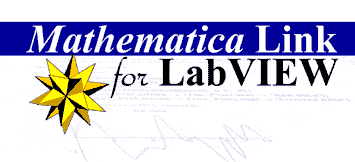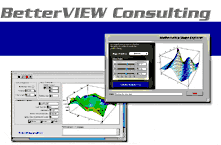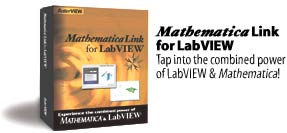|
|
|
|
Mathematica© Link for LabVIEW™
Features List
Primary Features:
- More than 75 low-level LabVIEW VIs implementing MathLink functions in LabVIEW.
- More than 50 high and intermediate-level LabVIEW VIs illustrating how the low-level functions can be combined to achieve specific results.
- 5 high-level VIs that require no modification to achieve several of the most common MathLink objectives including:
- Dynamically opening and running LabVIEW VIs from inside a Mathematica notebook
- Acquiring data using LabVIEW, then processing it interactively in a Mathematica notebook
- Passing parameters and results from one application to the other.
- Sending scripts and numeric computations from LabVIEW to the MathKernel for evaluation
- Graphing and visualizing LabVIEW data or abstract functions using the MathKernel, then displaying the results directly on a LabVIEW panel.
- Sophisticated, run-time processing of LabVIEW parameters by the MathKernel
- Exporting LabVIEW data using one of several standard publication-quality graphics formats.
- and more.
- Complete, unrestricted access to all VI diagrams and the 'VIClient.m' module. End-users can modify all toolkit elements as necessary to precisely match their requirements.
Usability and Workflow Features:
- Direct access to all toolkit VIs through the User Library of the LabVIEW Functions palette,
- Direct access to the most useful intermediate and high-level VIs through the LabVIEW Tools menu.
- Electronic documentation available through the LabVIEW and Mathematica Help menus.
- Complete LabVIEW application examples demonstrating the high-level VIs in action including:
- a simple process simulation and control demo
- 'Mathematica Shape Explorer.vi'- a visualization demo
- 'Generate Mathematica Graphics file.vi' - demonstrating inter-applcation graphic generation and export functions
- a robotic control demo based on the Khepera robot
- a step-by-step example following the evolution of a project using a hybrid LabVIEW/Mathematica workflow.
- and more
New Features in version 2.0:
- All components updated for compatibility with Mathematica 4.x/5.0 and LabVIEW 6.x/7.0
- New demo material including:
- a new simulation and PID control demo
- a new Mathematica Shape Explorer Demo
- a new Mathematica Graphics File export demo
- a new notebook demo illustrating how to apply Mathematica curve-fitting and data-smoothing functions to LabVIEW-acquired data
- Functions palette items have been reorganized to improve usability.
- Convenient Tools menu functionality of previous versions has been improved and expanded through the use of a new VI Server aliasing scheme. (Duplicate copies of high-level VIs have now been removed from LabVIEW Project folder to eliminate VI versioning conflicts that could arise in previous Link releases.)
- Complete contents of the updated hard-copy manual is now available in a searchable, indexed .pdf file - easily accessed from the LabVIEW Help menu.
- Several intermediate and upper-level VI diagrams have been optimized.
- Innovative, new LabVIEW-based installer VI
|
|

|
|
Other Mathematica Link for LabVIEW Destinations:
More Information from Wolfram.com
|
Recommended Mathematica Titles:
|
Platform & Software Requirements:
Mathematica Link for LabVIEW Version 2.0 is fully compatible with Mathematica 5* and LabVIEW 7 Express. The minimum requirements are Mathematica 4.1 or higher and LabVIEW 6.0 or higher running on Windows 95/98/ME/NT/XP or Macintosh and is available for Windows 95/98/ME/NT/XP and pre-OSX** Macintosh platforms. (Support for previous LabVIEW and Mathematica versions is available for a limited number of configurations. Contact BetterVIEW for details.)
*Users planning to develop custom MathLink-enabled Notebooks using Mathematica 5 are directed to this application note.
** "Mathematica Link for LabVIEW" can also run under MacOSX "Classic" mode. Contact BetterVIEW for details.
|
|
|






